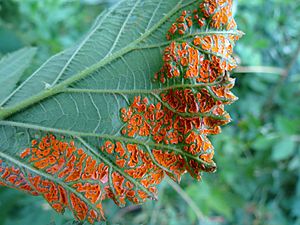Arthuriomyces peckianus facts for kids
Quick facts for kids Arthuriomyces peckianus |
|
|---|---|
 |
|
| Arthuriomyces peckianus found at Frostburg State University Arboretum, Frostburg, Maryland | |
| Scientific classification | |
| Genus: |
Arthuriomyces
|
| Species: |
peckianus
|
| Synonyms | |
|
|
Arthuriomyces peckianus is a type of fungus that causes a plant disease called orange rust. It mainly affects plants in the Rubus genus, which includes popular berries like raspberries and blackberries. This fungus can make these plants sick.
You can find Arthuriomyces peckianus in central and eastern North America. It is also present in parts of Europe and Asia. This means it's a widespread problem for berry growers in these regions.
Contents
What is Orange Rust?
Orange rust is a common plant disease. It is caused by certain types of fungi, including Arthuriomyces peckianus. This disease gets its name from the bright orange spots it creates on infected plants.
These orange spots are actually tiny spores of the fungus. Spores are like seeds for fungi. They help the fungus spread to other plants. When you see these spots, it means the plant is infected.
How Orange Rust Affects Plants
When Arthuriomyces peckianus infects a plant, it can cause several problems. The most noticeable sign is the orange powdery growth on the underside of leaves. This powder is made of millions of fungal spores.
Infected plants might look unhealthy. Their leaves can become twisted or deformed. The plant may also produce fewer berries, or the berries might be smaller. This can be a big problem for farmers who grow berries.
The fungus lives inside the plant's tissues. It takes nutrients from the plant, making it weaker. This is why it's called a "plant pathogen"—it's an organism that causes disease in plants.
Plants That Get Orange Rust
Arthuriomyces peckianus specifically targets plants in the Rubus genus. This group includes many well-known and delicious berries. Some examples are:
- Raspberries
- Blackberries
- Dewberries
- Boysenberries
If you have these plants in your garden, it's good to know about orange rust. Early detection can help protect your plants.
Where Arthuriomyces peckianus Lives
This fungus is found in several parts of the world. Its main homes are:
- North America (central and eastern regions)
- Europe
- Asia
This wide distribution means that berry plants in these areas are at risk. The fungus thrives in certain conditions, often preferring humid environments.
How Fungi Spread
Fungi like Arthuriomyces peckianus spread in several ways. Spores are the main method. These tiny particles can be carried by:
- Wind: Wind can blow spores from one plant to another, sometimes over long distances.
- Rain: Rain splashes can carry spores from infected leaves to healthy ones.
- Insects: Some insects might pick up spores and move them around.
- People: Garden tools, clothing, or even hands can accidentally transfer spores.
Once spores land on a suitable plant, they can start a new infection. This is why it's important to clean gardening tools.
Protecting Plants from Orange Rust
Farmers and gardeners use different methods to protect their berry plants. One common way is to plant varieties that are resistant to orange rust. These plants are naturally stronger against the fungus.
Removing infected plants or parts of plants can also help. If you see leaves with orange rust, it's best to carefully remove and destroy them. This stops the fungus from spreading further.
Good plant care also plays a role. Healthy plants are generally better at fighting off diseases. This includes proper watering, feeding, and making sure plants have enough space.
See Also

